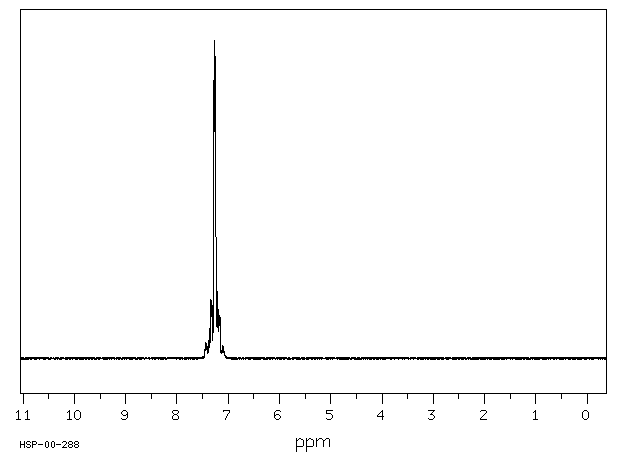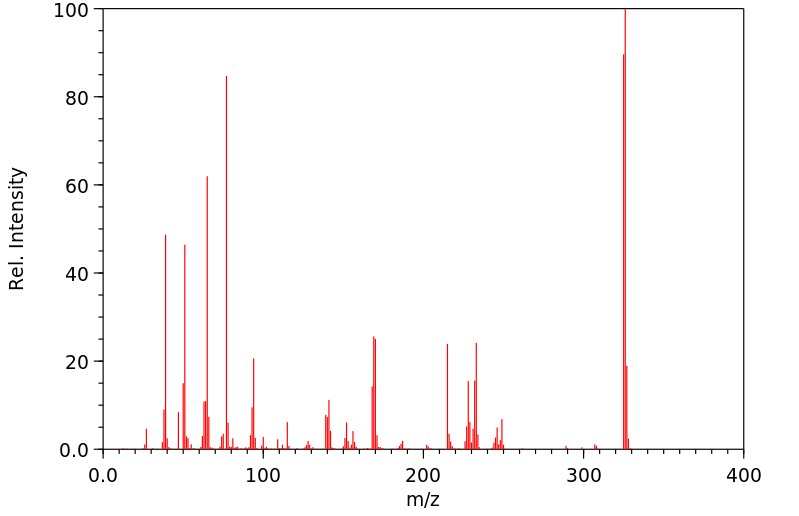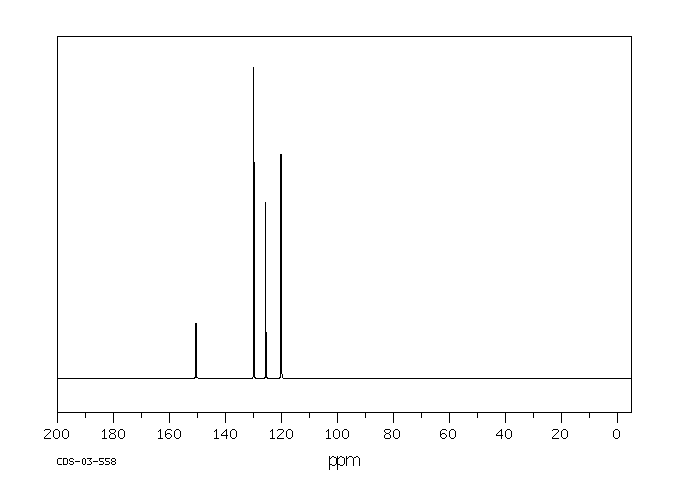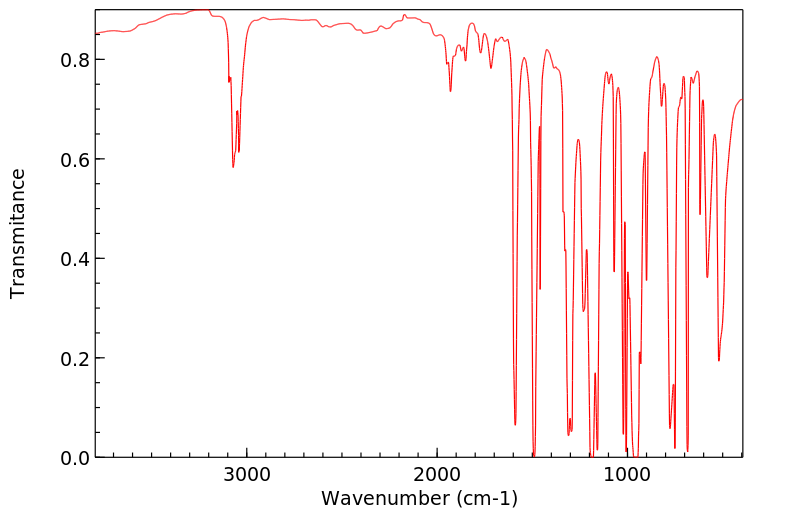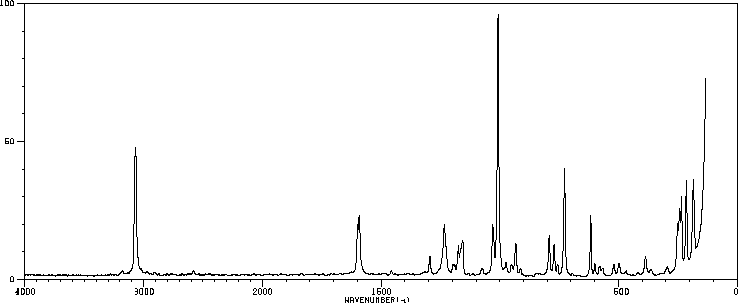磷酸三苯酯 | 115-86-6
-
物化性质
-
计算性质
-
ADMET
-
安全信息
-
SDS
-
制备方法与用途
-
上下游信息
-
文献信息
-
表征谱图
-
同类化合物
-
相关功能分类
-
相关结构分类
物化性质
-
熔点:48-50 °C (lit.)
-
沸点:244 °C/10 mmHg (lit.)
-
密度:1.2055
-
蒸气密度:11.3 (vs air)
-
闪点:435 °F
-
溶解度:20°C时水中的溶解度为0.0019g/L
-
暴露限值:TLV-TWA air 3 mg/m3 (ACGIH, OSHA, and NIOSH).
-
LogP:4.6 at 20℃
-
物理描述:Triphenyl phosphate appears as colorless crystals. (NTP, 1992)
-
颜色/状态:Crystals from ligroin; prisms from alcohol; needles from diethyl ether
-
气味:Odorless
-
蒸汽密度:1.19 (Air = 1)
-
蒸汽压力:2.00X10-6 mm Hg at 25 °C
-
分解:Hazardous decomposition products: Toxic gases and vapors (such as phosphoric acid fume and carbon monoxide) may be released in a fire involving triphenyl phosphate.
-
折光率:Index of refraction: 1.550 at 60 °C
-
保留指数:2320;2330;2359;2363;2366;2363;2363;2363;2342.6;391.9
-
稳定性/保质期:
常温常压下,磷酸三苯酯不分解,能与乙醚、氯仿、丙酮等溶剂混溶,微溶于乙醇,不溶于水,并具有阻燃性。在34℃时,其在水中的溶解度为0.001%。这种物质剧毒。
从化学性质来看,磷酸三苯酯对酸相对稳定,但对碱容易发生皂化反应。与氢氧化钡醇溶液一同煮沸时,生成二苯基磷酸钡。在冷却情况下用硝酸(相对密度1.5)进行硝化,则主要生成磷酸三(4-硝基苯基)酯;若使用硝酸和硫酸的混酸进行硝化,则生成磷酸三(2,4-二硝基苯基)酯。当与碳酸钾一同加热时,会生成苯酚、少量二苯醚及氧杂蒽酮。与氧化钙、氧化铝或氧化锌加热时,将生成苯酚和苯杂蒽;用氧化镁处理则会产生少量的二苯醚。磷酸三苯酯用乙醇钠处理后,则生成磷酸二乙酯的钠盐和乙基苯醚。
计算性质
-
辛醇/水分配系数(LogP):4.6
-
重原子数:23
-
可旋转键数:6
-
环数:3.0
-
sp3杂化的碳原子比例:0.0
-
拓扑面积:44.8
-
氢给体数:0
-
氢受体数:4
ADMET
安全信息
-
职业暴露等级:B
-
职业暴露限值:TWA: 3 mg/m3
-
TSCA:Yes
-
危险等级:9
-
立即威胁生命和健康浓度:1,000 mg/m3
-
危险品标志:N
-
安全说明:S16,S22,S24/25,S26,S36,S36/37,S60,S61
-
危险类别码:R50/53
-
WGK Germany:2
-
海关编码:2919900090
-
危险品运输编号:UN 3077 9/PG 3
-
危险类别:9
-
RTECS号:TC8400000
-
包装等级:III
-
危险性防范说明:P201,P264,P280,P301+P330+P331,P312
-
危险性描述:H302,H361,H372,H410
-
储存条件:密封存储于阴凉、通风的仓库中,远离火源和热源,并与氧化剂分开存放,严禁混存。需配备相应的消防器材。储存区域应准备好合适的材料以处理泄漏情况。
SDS
| 第一部分:化学品名称 |
| 化学品中文名称: | 磷酸三苯酯 |
| 化学品英文名称: | Triphenyl phosphate |
| 中文俗名或商品名: | |
| Synonyms: | |
| CAS No.: | 115-86-6 |
| 分子式: | 无资料 |
| 分子量: | 无资料 |
| 第二部分:成分/组成信息 |
| 纯化学品 混合物 | ||||||
| 化学品名称:磷酸三苯酯 | ||||||
|
| 第三部分:危险性概述 |
| 危险性类别: | |
| 侵入途径: | 无资料 |
| 健康危害: | 本品对人红细胞乙酰胆碱酯酶有轻度抑制作用,而对血浆酯酶无抑制。曾有1例致敏病例报道。未见其他职业中毒病例报道。 |
| 环境危害: | 无资料 |
| 燃爆危险: | 本品可燃。 |
| 第四部分:急救措施 |
| 皮肤接触: | 脱去污染的衣着,用流动清水冲洗。 |
| 眼睛接触: | 无资料 |
| 吸入: | 脱离现场至空气新鲜处。 |
| 食入: | 饮足量温水,催吐。就医。 |
| 第五部分:消防措施 |
| 危险特性: | 遇明火、高热可燃。 |
| 有害燃烧产物: | 一氧化碳、二氧化碳、氧化磷。 |
| 灭火方法及灭火剂: | 雾状水、泡沫、干粉、二氧化碳、砂土。 |
| 消防员的个体防护: | 无资料 |
| 禁止使用的灭火剂: | 无资料 |
| 闪点(℃): | 223 |
| 自燃温度(℃): | 无资料 |
| 爆炸下限[%(V/V)]: | 无资料 |
| 爆炸上限[%(V/V)]: | 无资料 |
| 最小点火能(mJ): | |
| 爆燃点: | |
| 爆速: | |
| 最大燃爆压力(MPa): | |
| 建规火险分级: |
| 第六部分:泄漏应急处理 |
| 应急处理: | 隔离泄漏污染区,限制出入。切断火源。建议应急处理人员戴防尘面具(全面罩),穿一般作业工作服。避免扬尘,小心扫起,置于袋中转移至安全场所。若大量泄漏,用塑料布、帆布覆盖。收集回收或运至废物处理场所处置。 |
| 第七部分:操作处置与储存 |
| 操作注意事项: | 密闭操作,全面通风。操作人员必须经过专门培训,严格遵守操作规程。建议操作人员佩戴自吸过滤式防尘口罩。远离火种、热源,工作场所严禁吸烟。使用防爆型的通风系统和设备。避免产生粉尘。避免与氧化剂接触。搬运时要轻装轻卸,防止包装及容器损坏。配备相应品种和数量的消防器材及泄漏应急处理设备。倒空的容器可能残留有害物。无资料 |
| 储存注意事项: | 储存于阴凉、通风的库房。远离火种、热源。应与氧化剂分开存放,切忌混储。配备相应品种和数量的消防器材。储区应备有合适的材料收容泄漏物。 |
| 第八部分:接触控制/个体防护 |
| 最高容许浓度: | TLVTN: ACGIH 3mg/m3 |
| 监测方法: | 无资料 |
| 工程控制: | 生产过程密闭,全面通风。 |
| 呼吸系统防护: | 空气中粉尘浓度较高时,建议佩戴自吸过滤式防尘口罩。 |
| 眼睛防护: | 必要时,戴化学安全防护眼镜。 |
| 身体防护: | 穿一般作业防护服。 |
| 手防护: | 戴一般作业防护手套。 |
| 其他防护: | 工作现场严禁吸烟。工作完毕,淋浴更衣。 |
| 第九部分:理化特性 |
| 外观与性状: | 白色、无臭结晶粉末, 微有潮解性。 |
| pH: | |
| 熔点(℃): | 50.52 |
| 沸点(℃): | 244(1.3kPa) |
| 相对密度(水=1): | 1.21 |
| 相对蒸气密度(空气=1): | 9.42 |
| 饱和蒸气压(kPa): | 0.01(20℃) |
| 燃烧热(kJ/mol): | |
| 临界温度(℃): | |
| 临界压力(MPa): | |
| 辛醇/水分配系数的对数值: | |
| 闪点(℃): | 223 |
| 引燃温度(℃): | 无资料 |
| 爆炸上限%(V/V): | 无资料 |
| 爆炸下限%(V/V): | 无资料 |
| 分子式: | 无资料 |
| 分子量: | 无资料 |
| 蒸发速率: | |
| 粘性: | |
| 溶解性: | 不溶于水,微溶于醇,溶于苯、氯仿、丙酮,易溶于乙醚。 |
| 主要用途: | 用作硝化纤维、醋酸纤维膜的阻燃性增塑剂、聚氯乙烯的增塑剂、粘胶纤维中的樟脑不燃性代用品。 |
| 第十部分:稳定性和反应活性 |
| 稳定性: | 在常温常压下 |
| 禁配物: | 强氧化剂。 |
| 避免接触的条件: | 无资料 |
| 聚合危害: | 无资料 |
| 分解产物: | 无资料 |
| 第十一部分:毒理学资料 |
| 急性毒性: | LD50:1300 mg/kg(小鼠经口);3000 mg/kg(大鼠经口);3000 mg/kg(兔经皮) LC50:无资料 |
| 急性中毒: | 无资料 |
| 慢性中毒: | 无资料 |
| 亚急性和慢性毒性: | |
| 刺激性: | 无资料 |
| 致敏性: | |
| 致突变性: | |
| 致畸性: | |
| 致癌性: |
| 第十二部分:生态学资料 |
| 生态毒理毒性: | 无资料 |
| 生物降解性: | 无资料 |
| 非生物降解性: | 无资料 |
| 生物富集或生物积累性: |
| 第十三部分:废弃处置 |
| 废弃物性质: | 无资料 |
| 废弃处置方法: | 用焚烧法处置。焚烧炉排出的气体要通过洗涤器除去。 |
| 废弃注意事项: | 无资料 |
| 第十四部分:运输信息 |
| |
| 危险货物编号: | 无资料 |
| UN编号: | 无资料 |
| 包装标志: | |
| 包装类别: | |
| 包装方法: | 无资料 |
| 运输注意事项: | 起运时包装要完整,装载应稳妥。运输过程中要确保容器不泄漏、不倒塌、不坠落、不损坏。严禁与氧化剂等混装混运。运输途中应防曝晒、雨淋,防高温。 |
| RETCS号: | |
| IMDG规则页码: |
| 第十五部分:法规信息 |
| 国内化学品安全管理法规: | 化学危险物品安全管理条例 (1987年2月17日国务院发布),化学危险物品安全管理条例实施细则 (化劳发[1992] 677号),工作场所安全使用化学品规定 ([1996]劳部发423号)等法规,针对化学危险品的安全使用、生产、储存、运输、装卸等方面均作了相应规定。 |
| 国际化学品安全管理法规: |
| 第十六部分:其他信息 |
| 参考文献: | |
| 填表时间: | 2004年12月14日 |
| 填表部门: | 无资料 |
| 数据审核单位: | 无资料 |
| 修改说明: | 无资料 |
| 其他信息: | |
| MSDS修改日期: | 1900年1月1日 |
制备方法与用途
磷酸三苯酯简称TPP,化学式为PO(OC₆H₅)₃,分子量为326.28。无色或白色针状结晶或结晶性粉末,无嗅,略有芳香气,无味。相对密度1.185(25℃),熔点48.4~49℃,沸点分别为370℃、260℃(2.666×10³Pa)、245℃(1.467×10³Pa)和244℃(1.333×10³Pa),闪点223℃,折射率1.550。该物质不溶于水,溶于苯、氯仿、乙醚、丙酮,易溶于乙醇。磷酸三苯酯挥发性低,具有阻燃性;塑化能力差,耐光及耐污染性不佳。大鼠经口LD₅₀为1600 mg/kg,工作场所最高允许浓度3 mg/m³。
该物质呈中等毒性,大白鼠经口LD₅₀为6.4 g/kg(体重)。多数国家卫生法规不允许其直接用于接触食品的制品;然而,美国FDA允许在规定剂量限度内将其用作食品包装材料的粘合剂。合成方法可通过苯酚与五氧化二磷或五氯化磷反应获得。
化学性质磷酸三苯酯为白色无臭结晶粉末,微有潮解性,易溶于苯、氯仿、乙醚和丙酮等有机溶剂,溶于乙醇而不溶于水。
用途磷酸三苯酯主要用于纤维素树脂、乙烯基树脂、天然橡胶及合成橡胶的阻燃增塑剂。此外,还应用于三乙酸甘油酯薄片和软片、硬质聚氨酯泡沫、酚醛树脂以及PPO等工程塑料的阻燃增塑剂。它也可作为气相色谱固定液(最高使用温度175℃),其选择性与聚乙二醇相似,特别适用于保留醇类化合物。另外,磷酸三苯酯还可用于增加塑料加工成型时的可塑性和流动性。
类别- 有毒物质
- 毒性分级:中毒
-
急性毒性:
- 口服-大鼠 LD₅₀: 3500 毫克/公斤;
- 口服-小鼠 LD₅₀: 1320 毫克/公斤
磷酸三苯酯易燃,遇热、明火或氧化剂燃烧,在火场会排出磷的氧化物烟雾。
储运特性应将磷酸三苯酯存放在低温、通风且干燥的地方,并与氧化剂分开存放。
灭火剂 职业标准- TWA:3 毫克/立方米
- STEL:6 毫克/立方米
上下游信息
-
上游原料
中文名称 英文名称 CAS号 化学式 分子量 磷酸二苯酯 diphenyl hydrogen phosphate 838-85-7 C12H11O4P 250.191 磷酸单苯酯 phosphoric acid monophenyl ester 701-64-4 C6H7O4P 174.093 亚磷酸三苯酯 triphenyl phosphite 101-02-0 C18H15O3P 310.289 1-二苯氧基磷酰氧基-4-叔丁基苯 tert-butylphenyl diphenyl phosphate 981-40-8 C22H23O4P 382.396 —— pentaphenoxyphosphorane 19613-06-0 C30H25O5P 496.499 (4-硝基苯基)二苯基磷酸酯 4-nitro-phenyl diphenyl phosphate 10359-36-1 C18H14NO6P 371.286 氯磷酸二苯酯 chlorophosphoric acid diphenyl ester 2524-64-3 C12H10ClO3P 268.636 —— diphenyl phosphoroiodidate 220185-50-2 C12H10IO3P 360.088 —— O,O,O-triphenyl selenophosphate 7248-72-8 C18H15O3PSe 389.249 O,O,O-三苯基硫代磷酸酯 O,O,O-triphenyl phosphorothioate 597-82-0 C18H15O3PS 342.355 -
下游产品
中文名称 英文名称 CAS号 化学式 分子量 磷酸二苯酯 diphenyl hydrogen phosphate 838-85-7 C12H11O4P 250.191 三(4-氯苯基)磷酸酯 tris(4-chlorophenyl) phosphate 3871-31-6 C18H12Cl3O4P 429.624 —— phosphoric acid tris-(4-bromo-phenyl ester) 40946-60-9 C18H12Br3O4P 562.977 磷酸单苯酯 phosphoric acid monophenyl ester 701-64-4 C6H7O4P 174.093 —— Tri-O-kresylphosphat —— C18H15O7P 374.287 —— 2-hydroxyphenyl diphenyl phosphate 138079-34-2 C18H15O5P 342.288 —— ethyl diphenyl phosphate 841-46-3 C14H15O4P 278.244 1-二苯氧基磷酰氧基-4-叔丁基苯 tert-butylphenyl diphenyl phosphate 981-40-8 C22H23O4P 382.396 二(4-叔-丁基苯基)苯基磷酸酯 bis(p-tert-butylphenyl) phenyl phosphate 115-87-7 C26H31O4P 438.504 三(4-叔丁基苯)磷酸盐 tris(4-(tert-butyl)phenyl) phosphate 78-33-1 C30H39O4P 494.611 磷酸丁基二苯酯 butyl diphenyl phosphate 2752-95-6 C16H19O4P 306.298 —— diphenyl phosphorofluoridate 403-65-6 C12H10FO3P 252.182 三(4-硝基苯基)磷酸酯 tris(p-nitrophenyl)phosphate 3871-20-3 C18H12N3O10P 461.281 苯基二甲基磷酸酯 dimethyl phenyl phosphate 10113-28-7 C8H11O4P 202.147 磷酸异癸基二苯酯 isodecyl diphenyl phosphate 29761-21-5 C22H31O4P 390.459 O,O,O-三苯基硫代磷酸酯 O,O,O-triphenyl phosphorothioate 597-82-0 C18H15O3PS 342.355 2-乙基己基二苯基磷酸酯 santicizer 141 1241-94-7 C20H27O4P 362.406 二乙基苯基磷酸酯 Diethyl phenyl phosphate 2510-86-3 C10H15O4P 230.2 - 1
- 2
反应信息
-
作为反应物:描述:参考文献:名称:在磷酸二(三)芳基酯中通过光挤出无金属合成芳烃摘要:已经开发了用于合成双芳烃的无金属路线。该方法基于在联芳基和三芳基磷酸酯的照射下发生的磷酸根部分的光挤出。该反应涉及一种激基复合物作为中间体,它特别适合于制备富电子的双芳烃。DOI:10.3762/bjoc.16.250
-
作为产物:参考文献:名称:使用次氟酸-乙腈络合物将膦,亚磷酸酯和次膦酸酯化合物快速高效地氧化为氧化膦,磷酸酯和次膦酸酯摘要:次氟酸乙腈络合物用作温和,快速和有效的试剂,可将多种膦,亚磷酸酯和次膦酸酯氧化为相应的氧化膦,磷酸酯和次膦酸酯化合物。DOI:10.1016/j.jfluchem.2005.02.012
-
作为试剂:参考文献:名称:单核和双核(吡啶基)二酰胺钌(II)氢配合物:配体控制的配位多样性和酮的催化转移氢化摘要:配体N,N -(1,4-亚苯基)-吡啶二酰胺 ( H 2 L1 ) 与 [Ru(PPh 3 ) 3 (CO)HCl] 反应生成双核配合物 [Ru 2 ( H 2 L1 )(PPh 3 ) 4 (CO) 2 H 2 ] 2+ [2Cl - ] - ( Ru1 )。另一方面,用两又一摩尔当量的[Ru(PPh 3 ) 3 (CO)HCl]处理配体N,N -(1,2-亚苯基)-吡啶二酰胺( H 2 L2) ,得到双核和单核配合物分别为[ Ru 2 (H L2 )(PPh 3 ) 3 (CO) 3 HCl 2 ] ( Ru2 ) 和 [Ru( HL2 )(PPh 3 ) 2 (CO)H] ( Ru3 )。使用 NMR、FT-IR 光谱技术、质谱和元素分析确定了配合物Ru1-Ru3的特性和结构。配合物Ru1-Ru3在多种酮的转移氢化中表现出高催化活性。氢化物配合物Ru1最活跃,而双核配合物Ru2比类似DOI:10.1016/j.jorganchem.2023.122970
文献信息
-
N-PHENYL-1,1,1-TRIFLUOROMETHANESULFONAMIDE HYDRAZONE DERIVATIVE COMPOUNDS AND THEIR USAGE IN CONTROLLING PARASITES申请人:Winzenberg Norman Kevin公开号:US20070238700A1公开(公告)日:2007-10-11Novel N-phenyl-1,1,1-trifluoromethanesulfonamide compounds useful for controlling endo and/or ectoparasites in the environment are provided, together with methods of making the same, and methods of using the inventive compounds to treat parasite infestations in vivo and ex vivo.提供了一种用于控制环境中内外寄生虫的新型N-苯基-1,1,1-三氟甲磺酰胺化合物,以及制备这些化合物的方法,以及利用这些创新化合物治疗体内和体外寄生虫感染的方法。
-
[EN] MACROCYCLIC COMPOUNDS FOR MODULATING IL-17<br/>[FR] COMPOSÉS MACROCYCLIQUES POUR UNE MODULATION D'IL-17申请人:ENSEMBLE THERAPEUTICS CORP公开号:WO2013116682A1公开(公告)日:2013-08-08The invention relates generally to macrocyclic compounds of formula I and their therapeutic use. More particularly, the invention relates to macrocyclic compounds that modulate the activity of IL-17 and/or are useful in the treatment of medical conditions, such as inflammatory diseases and other IL-17-associated disorders.这项发明通常涉及公式I的大环化合物及其治疗用途。更具体地,该发明涉及调节IL-17活性的大环化合物,或者用于治疗炎症性疾病和其他与IL-17相关的疾病的大环化合物。
-
Synthesis of Esters by Functionalisation of CO2申请人:Commissariat a L'Energie Atomique et aux Energies Alternatives公开号:US20170240485A1公开(公告)日:2017-08-24The invention relates to a method for (I) producing a carboxylic ester of formula (I). Said method comprises the steps of: a) bringing an organosilane/borane of formula Si or B into contact with CO 2 , in the presence of a catalyst and an electrophilic compound of formula (III), the groups R 1 , R 2 , R 3 , R 4 , R 5 , Y, and M′ being as defined in claim 1; and optionally b) recovering the compound of formula (I) produced.
-
[EN] OXIME ESTER PHOTOINITIATORS<br/>[FR] PHOTO-INITIATEURS À BASE D'ESTER D'OXIME申请人:BASF SE公开号:WO2021175855A1公开(公告)日:2021-09-10Disclosed are α-oxo oxime ester compounds based on carbazole derivatives which have specific substituent groups useful as a photoinitiator, as well as photopolymerizable compositions comprising said photoinitiator and ethylenically unsaturated compounds. The photopolymerizable compositions are useful, for example, in photoresist formulations for display applications, e.g. liquid crystal display (LCD), organic light emitting diode (OLED) and touch panel.
-
SYNTHESIS OF 1,1,2,3-TETRACHLOROPROPENE申请人:Honeywell International Inc.公开号:US20140221705A1公开(公告)日:2014-08-07The present invention provides an improved process for producing 1,1,2,3-tetrachloropropene. By using a first reactive distillation column for HCC-250fb dehydrochlorination, and a second reactive distillation column for HCC-240db dehydrochlorination/HCC-1230xf isomerization, the 1,1,2,3-tetrachloropropene manufacturing process can be greatly simplified, resulting in reduced equipment use, energy use, as well as increased productivity.
表征谱图
-
氢谱1HNMR
-
质谱MS
-
碳谱13CNMR
-
红外IR
-
拉曼Raman
-
峰位数据
-
峰位匹配
-
表征信息


